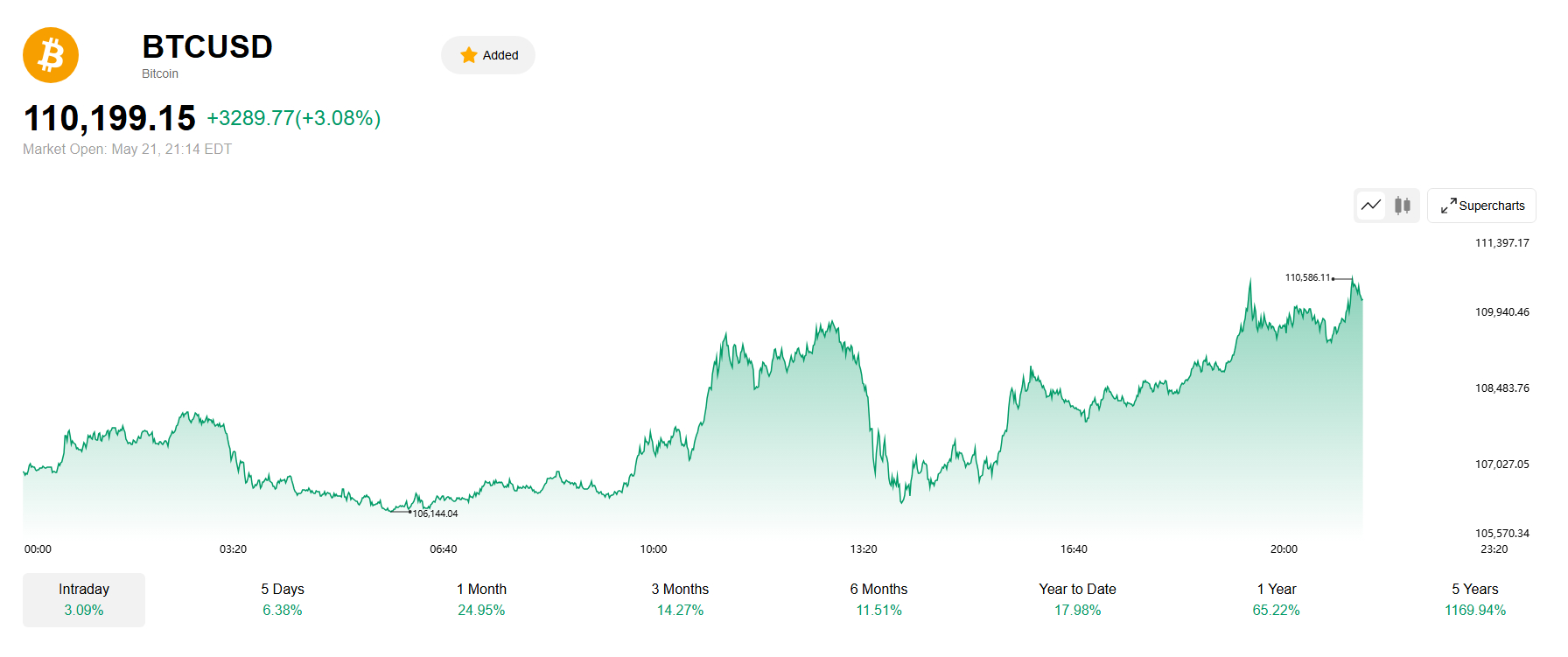Bitcoin Surges Above $110k Reaches All-Time High Amid Regulatory Tailwinds and Market Optimism
Bitcoin, the world’s leading cryptocurrency, has once again made headlines by briefly surging to an all-time high of $110,826.3, a milestone driven by advancing stablecoin legislation in the United St

Bitcoin, the world’s leading cryptocurrency, has once again made headlines by briefly surging to an all-time high of $110,826.3, a milestone driven by advancing stablecoin legislation in the United States and growing optimism under President Donald Trump’s administration.

This peak, which eclipsed its previous record set around Trump’s January 20 inauguration, reflects a confluence of regulatory clarity, macroeconomic uncertainty, and institutional enthusiasm. While broader financial markets retreated, Bitcoin’s ascent underscores its evolving role as both a speculative asset and a hedge against traditional economic risks.
The Regulatory Boost: Stablecoin Legislation Takes Center Stage
A key driver of Bitcoin’s recent surge is the advancement of stablecoin legislation in the U.S. Senate (GENIUS Act), a development that has sparked hopes of a more defined regulatory framework.
Stablecoins—cryptocurrencies pegged to stable assets like the U.S. dollar—play a vital role in the crypto ecosystem, supporting trading, lending, and acting as a reliable store of value. The proposed bill, which gained bipartisan support after a group of Democrats dropped their opposition, introduces tighter rules on anti-money laundering, foreign issuers, and consumer protections while ensuring uniform standards for domestic and foreign stablecoin issuers.
This legislative progress is widely viewed as a turning point for the crypto industry, which has long operated in a regulatory gray area. Michael Novogratz, CEO of galaxy digital, noted during an interview with reporters, “It’s the shift of approach from Gary Gensler and the SEC to this Trump administration, which has embraced our industry. That freed up the animal spirits both here and abroad.” The market’s positive response suggests that regulatory clarity could pave the way for greater adoption and legitimacy.
Bitcoin as a Safe Haven Amid Economic Turbulence
Beyond regulatory developments, Bitcoin’s rally is bolstered by its growing reputation as a hedge against macroeconomic instability.
With U.S. budget negotiations faltering and deficit spending on the rise, investors are increasingly wary of traditional assets. Novogratz emphasized this dynamic: “We’re in a really hard position in this country when you have this kind of debt... That is all good for Bitcoin and crypto assets as well.” As the U.S. dollar faces pressure and yield curves signal unease, Bitcoin is reclaiming its narrative as “digital gold,” a haven during times of financial uncertainty.
The crypto market’s technical indicators further reflect this bullish sentiment. Options traders have piled into bullish positions, with significant open interest in Bitcoin calls at strike prices of $110,000, $120,000, and even $300,000 expiring June 27, according to Deribit data. This surge in demand for short-dated calls signals expectations of continued upward momentum. Meanwhile, institutional interest remains strong, with Bitcoin futures open interest on the cme group up 23% from its April low and U.S. Bitcoin ETFs attracting $3.6 billion in inflows this May.
Bitcoin’s 14% year-to-date gain contrasts sharply with a 2% decline in the Nasdaq 100 since December, highlighting its outperformance of traditional risk assets. Corporate adoption is also accelerating, led by MicroStrategy’s $50 billion Bitcoin treasury strategy. Other firms, including Bitcoin miners and new public entities backed by crypto heavyweights, are following suit, offering investors diverse exposure to the asset.
Risks and Ethical Questions
Despite the optimism surrounding Bitcoin’s rally, significant risks persist. Regulatory clarity is advancing but remains incomplete, leaving the crypto industry vulnerable to sudden policy shifts. The path to comprehensive regulation is fraught with challenges, and any missteps could undermine the market’s newfound momentum.
Adding to this uncertainty is the proposed GENIUS bill, which has sparked alarm among experts. Hilary Allen, a law professor at American University who served on the congressional commission studying the 2008 financial crisis, warned in an interview on Tuesday that while corruption in the crypto space merits attention, it’s not her primary concern. What keeps her up at night, she said, is the GENIUS bill—described as “a car crash in slow motion.” She explained, “This bill would allow the largest tech platforms to essentially become the functional equivalent of banks. The last crisis was caused by ‘too big to fail’ financial institutions. The size of some of these tech platforms makes that look quaint.”
The GENIUS bill offers minimal resistance to tech giants like Meta, Amazon, or Google seeking to issue their own stablecoins. Companies would need approval from a regulatory triad—the Treasury, the FDIC, and the Federal Reserve—but under the Trump administration’s pro-crypto stance, this hurdle may prove insignificant. Meta, for instance, previously ventured into cryptocurrency with its Libra project (later renamed Diem) in 2019, only to abandon it in 2022 amid regulatory pushback. Now, according to a recent Fortune report, Meta is exploring stablecoins again, this time to facilitate in-app transactions. This could keep users within its ecosystem while generating valuable data on spending habits, amplifying both its influence and potential risks.
Allen’s deepest worry is the vulnerability of stablecoins to financial shocks, such as runs, even if backed by 100% cash reserves. She dismisses the optimistic assumption that such backing ensures stability as “ridiculous,” pointing to money-market mutual funds—structurally similar to stablecoins—that experienced runs requiring bailouts in 2008 and 2020. A more recent example is the 2023 Silicon Valley Bank collapse, where the government stepped in to support the stablecoin USDC, tied to the bank’s $3 billion in uninsured deposits. “We may be setting ourselves up to essentially have to bail out these large tech platforms,” Allen cautioned, underscoring the potential burden on taxpayers.
Ethical concerns further complicate the landscape. President Trump’s private dinner with major holders of his memecoin at his golf club has drawn scrutiny, with critics arguing it blurs the line between political influence and financial gain. Ethics experts warn that such interactions could establish a precedent for privileged access tied to transactions benefiting the president, raising questions about conflicts of interest.
Together, these developments highlight the precarious balance the crypto industry must strike. While regulatory progress signals opportunity, the risks—from systemic financial threats posed by bills like GENIUS to ethical dilemmas tied to political influence—serve as stark reminders of the challenges ahead. The market’s long-term success hinges on its ability to confront these issues head-on.
Conclusion
Bitcoin’s brief climb to $109,856 marks a pivotal moment for the cryptocurrency, driven by regulatory progress, economic uncertainty, and institutional enthusiasm. The advancement of stablecoin legislation signals a maturing industry, while Bitcoin’s resilience as a hedge underscores its growing appeal. Yet, challenges—ranging from regulatory hurdles to ethical concerns—remind us that the road ahead is complex. As the crypto market navigates these dynamics, its ability to balance innovation with responsibility will shape its long-term trajectory.
Disclaimer: The views in this article are from the original Creator and do not represent the views or position of Hawk Insight. The content of the article is for reference, communication and learning only, and does not constitute investment advice. If it involves copyright issues, please contact us for deletion.